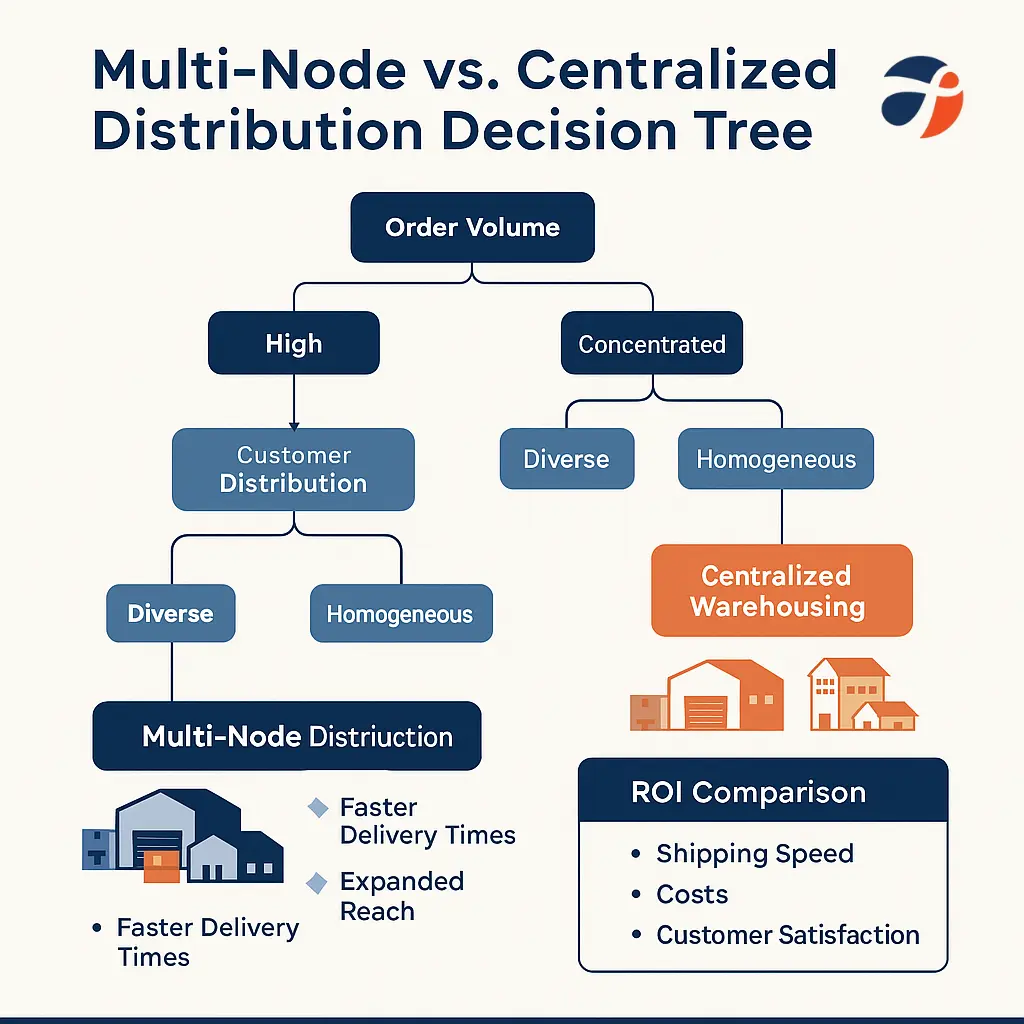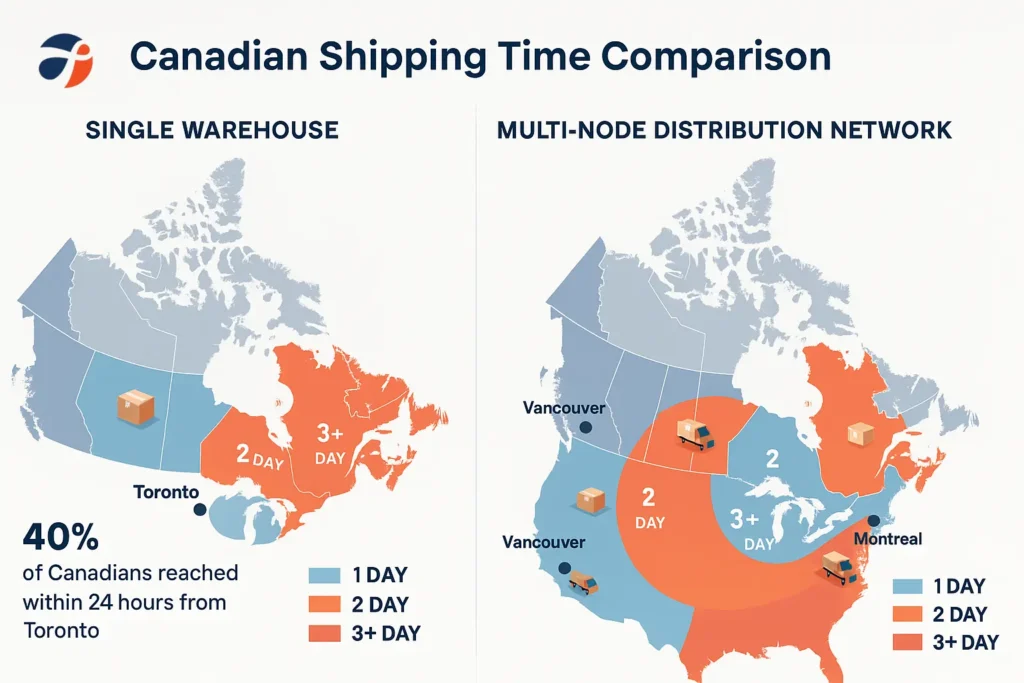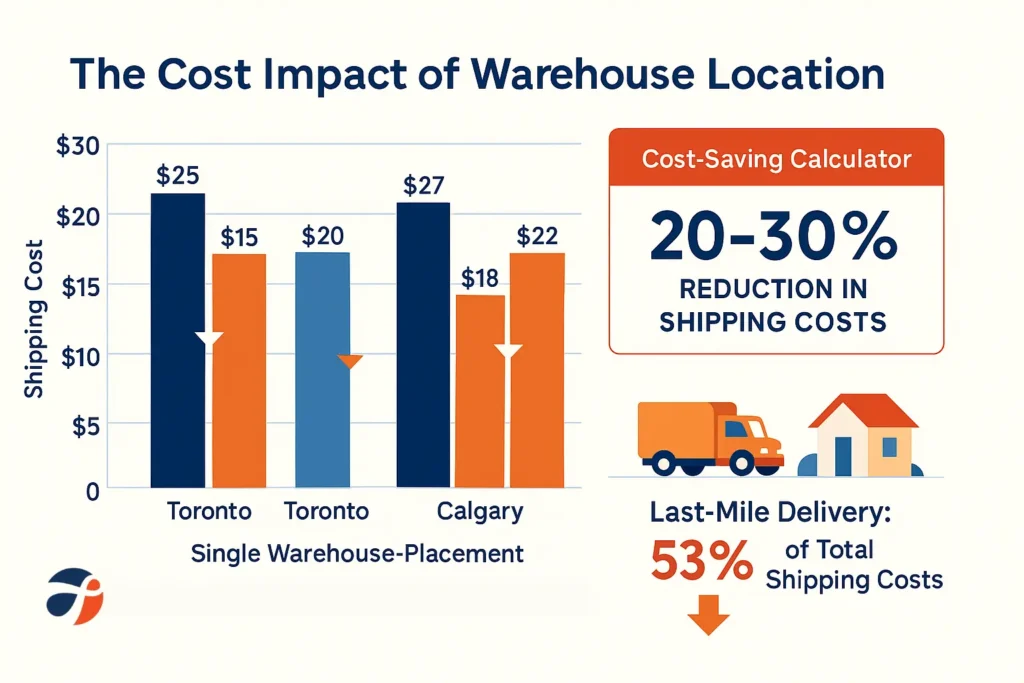The cost and speed of product delivery to customers are directly impacted by the strategic location of warehouses. Businesses with strategically placed distribution centers in Canada can cut shipping costs by 20–30% and delivery times from 5-7 days to just 1-2 days. This article examines how warehouse location impacts cross-border logistics and last-mile delivery, as well as why companies that work with 3PL providers like MacMillan Supply Chain Group benefit from strategic Canadian warehousing solutions that give them a competitive edge.
Why Your Warehouse Location Matters More Than Ever
Ever ponder why some orders placed online arrive the following day while others take a week to arrive? In many cases, the warehouse location rather than the shipping method is the key. Customers expect speedy delivery at competitive prices in today’s fast-paced market. Because of this, choosing where to locate your warehouse is one of the most important aspects of your logistics plan.
We at MacMillan Supply Chain Group have personally witnessed how a well-chosen warehouse location can revolutionize an organization. 40% of Canadian consumers can be reached in a day by a Toronto fulfillment center, whereas a poorly located warehouse may take three to five days to reach the same customers. The distinction has an impact on your bottom line, customer satisfaction, and competitiveness in the current market in addition to shipping speed.
Let’s explore why warehouse location has become the cornerstone of successful supply chain optimization.
The Distance Factor
The main determinant of shipping speed is distance. Your products will arrive more quickly if your warehouse is located close to your customers. This simple idea has significant business ramifications.
A package may arrive the following day if it is shipped from a fulfillment center in Toronto to a customer in Ontario. It might take three to four days to ship the same package from Vancouver to Ontario using the same shipping method. This discrepancy is due to geography rather than efficiency.
The size of our nation must be taken into consideration when developing warehousing strategies in Canada. Businesses must carefully consider where to store inventory because major population centers are dispersed over thousands of kilometers. Western provinces could be adequately served by a single warehouse in Calgary, but eastern customers would have to wait days longer than necessary.
The best approach? Many businesses find that an Ontario warehouse hub serves as an excellent starting point, with additional distribution centers in Canada’s western and eastern regions as they grow. This multi-node distribution approach ensures that no customer is too far from your products.
Breaking Down Shipping Costs
The cost of shipping a package increases with each kilometer of travel. You essentially pay for additional distance when your warehouse location is far from your customers. These expenses mount up quickly and can have a big effect on your profit margins.
Take a look at these actual numbers:
- Transporting a 5 kg parcel inside the same province: $8–12 for shipping the identical package to more than three provinces: $18–25
Costs of last-mile delivery in cities: 53 percent of the total cost of shipping
Strategic warehouse placement can significantly lower these expenses. Compared to a competitor with a single warehouse, a company with distribution centers in both Toronto and Vancouver may save 40% on shipping.
Location affects more than just transportation costs. There are large regional differences in labor availability, real estate values, and utility costs. The Greater Toronto Area, for instance, has more expensive warehouse space per square foot than smaller cities, but the savings on shipping and quicker delivery times frequently make the difference.
The secret is figuring out the sweet spot, which our logistics experts at MacMillan Supply Chain Group are skilled at determining, where shipping and operating costs add up to the lowest overall cost.

Multi-Node vs. Centralized Distribution
Should your business operate from one large warehouse or several smaller ones across Canada? This question faces every growing business, and the answer depends on your specific needs.
A centralized approach with one major warehouse offers simplicity and lower facility costs. However, a multi-node distribution network with strategically placed warehouses provides faster shipping speeds and reduced shipping costs. The trade-off is more complex inventory management and higher facility expenses.
Consider these approaches:
- Single Central Hub: Works well for specialized products with nationwide demand but lower order volume
- East-West Strategy: Two warehouses (typically Ontario and BC) covering eastern and western Canada
- Regional Network: Multiple smaller facilities near major population centers for fastest possible delivery
For businesses shipping to both Canadian and American customers, cross-border logistics adds another layer of complexity. Warehouses near border crossings like Windsor or Niagara Falls can facilitate smooth US-Canada shipping while maintaining fast delivery to Canadian customers.
MacMillan’s network of distribution centers in Canada allows businesses to implement the right strategy for their unique needs, whether that’s a single Ontario warehouse hub or a comprehensive national network.
Urban Proximity and Delivery Speed
More than half of all shipping expenses go toward the “last mile,” which is the last section of delivery from the local distribution center to the customer’s door. The location of the warehouse is essential to making the most of this costly step.
- Last-mile distances are shortened by urban warehouses located close to city centers, allowing for same-day or next-day delivery options.
- Reduced delivery expenses and fuel consumption
- Shorter routes result in lower carbon emissions; more scheduling flexibility for deliveries
Local clients can receive same-day delivery from a Toronto fulfillment center, which is not feasible with a warehouse located outside of the city. Beyond just speed, this proximity advantage opens up possibilities for competitive service offerings that are impossible for distant warehouses to match.
However, the cost of real estate is usually higher for urban warehouses. Determining whether the cost savings and shipping speed benefits of paying more for city center proximity are sufficient to make the investment worthwhile is crucial. The answer is becoming more and more “yes” for many companies catering to urban clients.
The Hidden Costs of Poor Placement
The consequences of picking the incorrect warehouse location go well beyond the apparent shipping delays and expenses:
- Inventory Imbalances: To avoid stockouts and tie up capital in excess inventory, you need a larger safety stock when your warehouse is far from customers.
- Client Dissatisfaction: Modern customers anticipate prompt delivery. According to a study, poor delivery times caused 45% of online shoppers to abandon their carts.
- Limited Service Options: Without the use of pricey premium shipping services, same-day or next-day delivery is not feasible due to distant warehouses.
- Inefficient Returns Processing: The process gets slower and more costly when returns have to travel far to get to warehouses.
- Weather Vulnerabilities: Relying on a single warehouse in one geographic region makes your entire supply chain vulnerable to regional weather disruptions.
- Cross-Border Complications: Inadequately located warehouses complicate international shipping by increasing duties and requiring longer customs clearance times.
- Carrier Limitations: Your negotiating power and service options are diminished in some remote areas due to a lack of carrier options.
When compared to companies with well-optimized warehouse networks, these problems exacerbate over time, resulting in severe competitive disadvantages.

MacMillan’s Strategic Approach to Warehouse Placement
We at MacMillan Supply Chain Group have created a thorough strategy for warehouse location optimization that takes into account these typical issues:
Location Analysis Driven by Data
We start by looking at your customer data to find trends in order density across Canada. This helps you determine the best location for your warehouse by showing you where your customers are concentrated. With 40% of Canadians within a day’s drive, our Ontario warehouse hub is frequently a great place for businesses with clients across the country to start.
Distribution Networks with Multiple Nodes
We use multi-node distribution strategies for companies that need faster nationwide delivery. We can deliver to the majority of Canadian addresses in 1-2 days by strategically placing inventory. You can begin with a single location and grow as needed thanks to our network of distribution centers in Canada.
Optimizing Cross-Border Logistics
We set up warehouses to enable effective cross-border shipping for companies that serve both Canadian and American clients. Our facilities close to important crossing points expedite customs procedures and shorten international shipment transit times.
Partnerships for Last-Mile Delivery
We are able to provide competitive rates and service levels for last-mile delivery because of the relationships we have built with leading carriers across Canada. Even during busy times, dependable service is guaranteed thanks to our partnerships with several carriers at our fulfillment center in Toronto.
Technology for Inventory Balancing
In order to reduce shipping distances, our sophisticated inventory management systems automatically redistribute stock across locations based on demand patterns. This preserves ideal inventory levels while cutting down on shipping expenses and delivery times.
Seasonal Adaptability
We provide adaptable warehouse space that can grow or shrink as needed for companies with seasonal demand swings. As a result, there is no need to dedicate space for peak-season inventory throughout the year.
Services for Supply Chain Optimization
Our team examines your entire supply chain to find areas for improvement in addition to warehouse location. By taking a comprehensive approach, warehouse placement is guaranteed to align with distribution, transportation, and procurement plans.
Results in the Real World
Our customers usually experience: – A 20–30% decrease in shipping expenses – A 40–60% improvement in delivery times
- A 15% reduction in the cost of carrying inventory
- A 25% rise in customer satisfaction ratings
We develop specialized solutions that turn shipping from a cost center to a competitive advantage by fusing key Canadian warehouse locations with cutting-edge logistics technology and skilled management.

How to Increase Shipping Costs and Speed
Are you prepared to optimize your warehouse location plan? Here’s how to begin:
- Examine Your Present Circumstances
Start by mapping out your clientele and figuring out typical shipping costs, times, and distances. Determine which areas incur the highest shipping costs or the longest delays. Improvements will be measured with the aid of this baseline data. - Examine Your Plans for Growth
In two to three years, where will your clients be? Your ideal warehouse setup may change as you enter new markets. Consider future expansion as well as present requirements. - Assess Options for Multiple Nodes
Determine the advantages and disadvantages of adding more warehouse locations. The cost of running several facilities is frequently offset by the shipping savings and higher sales from quicker delivery. - Evaluate Buy vs. Make Choices
Assess if it makes more sense for your company to work with a 3PL provider or to create your own warehouse network. Working with a reputable 3PL like MacMillan Supply Chain Group offers most expanding businesses more flexibility and quicker implementation. - Launch a Pilot Program
Before making a complete move, test a new warehouse location with a portion of your inventory. This enables you to verify the advantages with little danger. - Put Technology Support into Practice
Make sure you have the order routing and inventory management systems required to accommodate several warehouse locations. For effective operations and inventory visibility to be maintained, these systems are necessary.
Collaborate with MacMillan Supply Chain Group
Working with professionals who have already resolved these issues is the quickest way to put an ideal warehouse location strategy into action. The following is what MacMillan Supply Chain Group provides:
- Immediate access to strategically located distribution centers in Canada
- Experienced warehouse management teams
- Advanced technology for inventory and order management
- Flexible space that grows with your business
- Competitive rates through our established carrier networks
Contact us today for a free consultation on how our Canadian warehousing solutions can improve your shipping speed and reduce costs. Our team will analyze your specific needs and develop a customized strategy to optimize your warehouse locations for maximum efficiency and customer satisfaction.
FAQS
The distance packages must travel to reach customers is determined by the location of the warehouse. While shipping from Vancouver may take three to four days, a Toronto fulfillment center can deliver to customers in Ontario in just one day. Ground shipping times usually increase by one day for every 500 kilometers. When compared to a single warehouse location, the strategic placement of distribution centers in Canada can cut average delivery times by 40–60%.
This is contingent upon your service level goals, customer distribution, and order volume. Many mid-sized companies begin with a warehouse hub in Ontario and, as they expand, add locations in western and eastern Canada. Two to three well-located warehouses are frequently advantageous for companies with 1,000 or more monthly orders and clients spread across several provinces. MacMillan can assist in assessing your unique requirements in order to identify the best setup.
After optimizing warehouse locations, the majority of businesses experience a 20–30% reduction in shipping costs. For instance, switching from a single warehouse to a multi-node distribution network could save a company that ships 5,000 packages a month between $25,000 and $40,000. Better carrier rates, shorter shipping distances, and more effective last-mile delivery are the sources of the savings.
Because it: 1) gives 40% of Canadian consumers next-day ground access; 2) offers a vast transportation network, including major highways and close proximity to the U.S. border; 3) makes a large labor pool available for warehouse operations; and 4) acts as a central hub for the majority of major carriers, guaranteeing competitive shipping rates and service options, the GTA is an excellent Ontario warehouse hub.
The efficiency of US-Canada shipping can be greatly increased by locating warehouses close to important border crossings. Faster customs clearance and shorter international shipping times are made possible by locations close to Windsor, Niagara Falls, or Vancouver. Strategic warehouse placement can cut cross-border shipping costs by 15–25% and times by 1-3 days for companies with significant U.S. sales.
The basic physics of distance cannot be overcome by sophisticated technology, even though it increases warehouse efficiency. A package cannot travel 3,000 km as fast or affordably as one traveling 300 km, even with the most advanced systems. Strategic warehouse location and technology work best together, not in place of one another.
It usually takes six to twelve months to build your own warehouse network. However, you can instantly access existing distribution centers in Canada by partnering with MacMillan Supply Chain Group. The majority of clients can adopt a new warehouse strategy in 30 to 60 days, and quantifiable increases in shipping costs and speed will show up almost instantly.
A hybrid strategy, which keeps year-round inventory in central locations while adding temporary capacity in key regions during peak periods, is frequently advantageous for businesses with large seasonal fluctuations. You can scale up or down space according to seasonal needs with MacMillan's flexible warehousing solutions without making long-term commitments.
Customer satisfaction scores, inventory turnover rate, shipping cost per order, average delivery time to customers, and perfect order rate—where orders are delivered complete and on time—are important metrics. Successful warehouse location optimization is indicated by improvements in these metrics.
We offer end-to-end support, which includes carrier partnerships for economical shipping, inventory management systems that facilitate multi-location operations, access to our network of strategically placed warehouses across Canada, data analysis to determine the best locations, and continuous optimization to adjust to shifting business requirements. Our knowledge of supply chain optimization and Canadian warehousing guarantees that your warehouse location strategy will yield the greatest possible returns.




